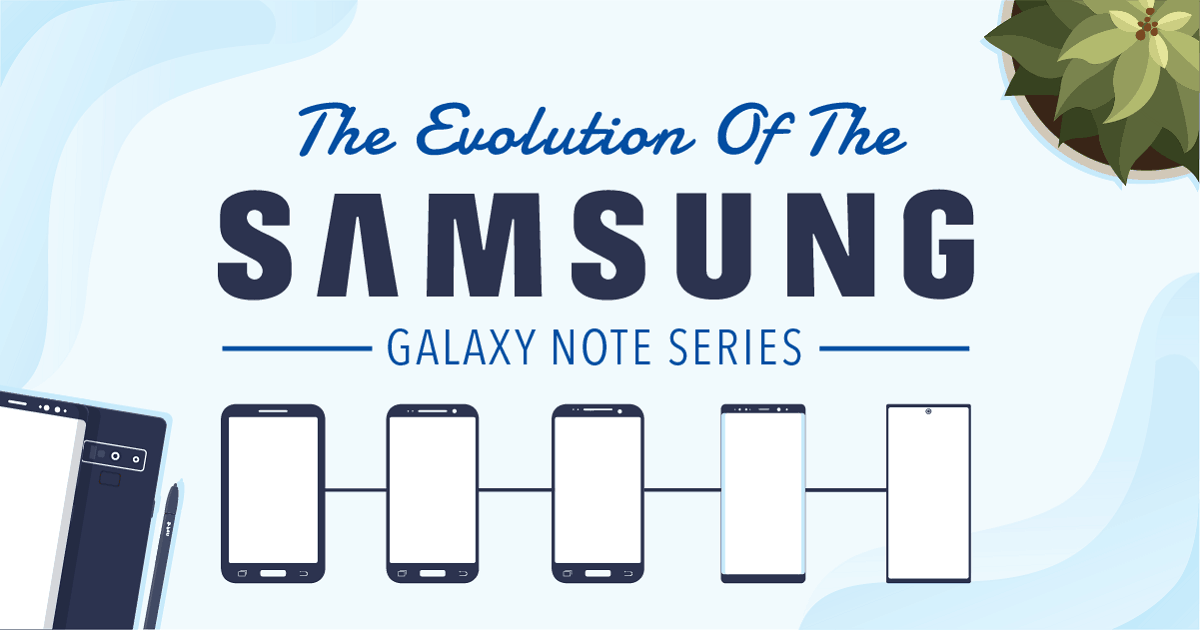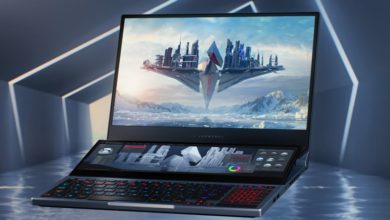The Evolution of The Samsung Galaxy Note Series

 When Samsung launched its first Galaxy Note, the company knew that the old era in the development of smartphones is coming to an end to make space for a new and more turbulent one – the age of the real big phones.
When Samsung launched its first Galaxy Note, the company knew that the old era in the development of smartphones is coming to an end to make space for a new and more turbulent one – the age of the real big phones.
Samsung’s breakthrough in 2011 marked the outset of what we know nowadays as the “phablet” – a hybrid between a phone and a tablet. Samsung is ready to reset the bar in August this year with the launch of the Galaxy Note 10+. The infographic below illustrates the oh-so meteoric history of the iconic Samsung Galaxy Note Series.

Feel free to download and share this infographic on your website. Please include attribution to Gadgetsdeck.com with the Infographic. Click here to download the infographic in high resolution.
Samsung Galaxy Note – October 2011
 When the first Note came on the scene, the idea of it wasn’t in full bloom because of the mixed reactions. Some anathematized the father of the Note Series, claiming it’s extrinsic and awkward to hold such a “gigantic” phone in their hand. Others, however, greeted with open arms the concept of a larger 5.3-inches Super Amoled Display because of these so many possibilities it offered.
When the first Note came on the scene, the idea of it wasn’t in full bloom because of the mixed reactions. Some anathematized the father of the Note Series, claiming it’s extrinsic and awkward to hold such a “gigantic” phone in their hand. Others, however, greeted with open arms the concept of a larger 5.3-inches Super Amoled Display because of these so many possibilities it offered.
The Galaxy note was a real beast back then, powered by a 2,500 mAh removable battery, with its 1 GB RAM, and 16GB/32GB internal storage. And if this seems ridiculous to some now, it supported Micro SD Card up to 64GB additional storage.
Back then it had the well-known S Pen and it featured Exynos 4211 Dual Processor and an Android 2.3.5, upgradable to 4.1.2. The 8MP Rear Camera with AF was enough to facilitate users’ needs and the 2MP Front Camera made good selfies before the term was even invented.
Samsung Galaxy Note 2 – September 2012
 Samsung built a bridge between the phones and the tablets and there was no going back. And as size always matters, in 2012 large was the new black. Despite those scandalized by the enormous screen of Note, Samsung offered even a bigger 5.5-inches Super Amoled one by launching Note 2.
Samsung built a bridge between the phones and the tablets and there was no going back. And as size always matters, in 2012 large was the new black. Despite those scandalized by the enormous screen of Note, Samsung offered even a bigger 5.5-inches Super Amoled one by launching Note 2.
But that wasn’t the only change – the standard sim turned into a micro sim, the RAM became 2GB, the internal storage jumped to 64GB most, the Dual Processor stepped back to make room for Exynos 4412 Quad-Core Processor, and the 2,500mAh battery was replaced by a 3100 mAh one.
The rear camera remained 8MP; however, the front camera was an exception from the upgrades because it went down to 1.9MP. The S pen of Note 2 became more ergonomic and easy to work with and allowed even better possibilities such as previewing images or emails or checking calendar details.
Samsung Galaxy Note 3 – September 2013
 Just a year later a new child in the Note Family was born – Galaxy Note 3 with a 5.7-inch Full HD display protected by Corning Gorilla Glass 3. And if the predecessors felt too cheap and plastic according to some, besides the Full HD upgrade, Note 3 came with a faux-leather finish that complemented its design.
Just a year later a new child in the Note Family was born – Galaxy Note 3 with a 5.7-inch Full HD display protected by Corning Gorilla Glass 3. And if the predecessors felt too cheap and plastic according to some, besides the Full HD upgrade, Note 3 came with a faux-leather finish that complemented its design.
It ran on Android 4.3, upgradable to Android 5.0, and it featured Exynos 5420 Octa-Core processor. Note 3 was the first smartphone with a Micro USB 3.0 support which allowed fast transfer of the user’s data.
The rear camera was improved to 13MP and could shoot 4K videos, which was also a first, but the real upgrade out there was the Air Command that activated automatically when the stylus is taken from the slot and that enabled users’ smooth exploration of the functions of Action Memo, Scrap Booker, Screen Write, and other S Pen-compatible apps.
Samsung Galaxy Note 4 – October 2014
 With Note 4 Samsung didn’t strive for enlarging the size once again so they kept about their 5.7-inches Super Amoled Display, protected by Corning Gorilla Glass 4. The company’s aim this time was concentrated on the polishing their Note in and out.
With Note 4 Samsung didn’t strive for enlarging the size once again so they kept about their 5.7-inches Super Amoled Display, protected by Corning Gorilla Glass 4. The company’s aim this time was concentrated on the polishing their Note in and out.
The aluminum frame of the corpus added another touch to the premium style of the Note Family. The 3GB RAM was saved to ensure the seamless multitasking; however, the Exynos processor was upgraded to the more powerful 5433 version.
With Note 4 the fast charging in the Note Family was introduced and the fingerprint reader on Home Button guaranteed user’s security even when in the wrong hands. A drawback to some was the fact that it came only in the 32GB variant, but the SD Card slot supported up to 256GB external space.
The dual camera of Note 4 could take photos with both of its sensors working simultaneously. The rear camera’s megapixels became 16 so that it could take unbeatable top-notch photos and 4k videos.
Samsung Galaxy Note Edge – November 2014
 Although after the launch of Note 4, in 2015 the world expected Note 5, Samsung surprised us with an out-of-the-blue digression by introducing a month later an experiment in the portfolio – their Note Edge, the father of what happens to be one of the company’s most striking signatures – the curved edge screen.
Although after the launch of Note 4, in 2015 the world expected Note 5, Samsung surprised us with an out-of-the-blue digression by introducing a month later an experiment in the portfolio – their Note Edge, the father of what happens to be one of the company’s most striking signatures – the curved edge screen.
The size of the screen was reduced just the tiniest bit with the 5.6 inches Super Amoled Display with 524 ppi Density. However, it created an illusion that the size is bigger because of stretching-to-the-side conception.
Note Edge features an Android 4.4, upgradable to 6.00, and a Snapdragon 805 processor. Users could choose between 32GB or 64GB internal storage. To sum it up, Note Edge has many of the characteristics of Note 4 with the major difference that Edge has the newly-introduced curved OLED display.
Samsung Galaxy Note 5 – August 2015
 Samsung didn’t wait for fall to bomb the world in 2015 with their Note 5 and it’s (w)holy-new design concept. Note 5 solidly stated that the plastic exterior is long forgotten by introducing the all-glass slim design with metal around the edge that ranked the Note Family up the sleek-style hierarchy.
Samsung didn’t wait for fall to bomb the world in 2015 with their Note 5 and it’s (w)holy-new design concept. Note 5 solidly stated that the plastic exterior is long forgotten by introducing the all-glass slim design with metal around the edge that ranked the Note Family up the sleek-style hierarchy.
Note 5 remained with its trademark 5.7-inch Super Amoled Display, but the glass smartphone required more protection so not the only front but back Gorilla Glass protection was also introduced.
The micro sim was replaced by a nano one. The Android – with 5.1, upgradable to 7.0. The fingerprint sensor concept was kept. Samsung Pay became available for the users who’d like to pay for their stuff through the smartphone. The RAM went up to 4GB. However, Samsung’s decision to exclude the external SD card slot was severely criticized.
The Quick Charge 2.0 function was available but a real advantage of the selfie lovers was the 5MP f/1.9 front camera that featured Dual Video Call.
Samsung Galaxy Note 7 – September 2016
 Principles of the logic claim that Note 6 is on its way after the launching of Note 5 in 2015. So, either Samsung is not very good at counting, or they offered something extraordinary in 2016 that deserved a number skip. That’s how Note 7 appeared – the first in the Note Family to enjoy an edge to edge 5.7-inch Super Amoled display with Corning Gorilla Glass 5 protection.
Principles of the logic claim that Note 6 is on its way after the launching of Note 5 in 2015. So, either Samsung is not very good at counting, or they offered something extraordinary in 2016 that deserved a number skip. That’s how Note 7 appeared – the first in the Note Family to enjoy an edge to edge 5.7-inch Super Amoled display with Corning Gorilla Glass 5 protection.
Note 7 came with Android 6.0 Marshmallow and hybrid dual sim. The fingerprint control looked amateur against the backdrop of the intelligent iris scanner. The RAM remained 4GB, the storage – 64GB but Note 7 allowed up to 1TB external storage. It’s the first Samsung smartphone with USB-C connector.
Another first in the family was that Note 7 was dust and waterproof. However, if we remember well, there was trouble in regard to the battery which caused many Note 7 overheat and explode (some even caused accidents in the hands of their owners).
Samsung Galaxy Note 8 – September 2017
 2017 brought about a change and what a change! Samsung renewed their larger-than-life striving for the screen size, introducing their Note 8 with an entirely new design and a 6.3-inches Super Amoled Display. And if it was all about the size in the beginning, with Note 8 its significance melted before the gorgeous Infinity Display.
2017 brought about a change and what a change! Samsung renewed their larger-than-life striving for the screen size, introducing their Note 8 with an entirely new design and a 6.3-inches Super Amoled Display. And if it was all about the size in the beginning, with Note 8 its significance melted before the gorgeous Infinity Display.
Note 8 featured 6GB RAM and up to 256GB internal storage. It’s Android 7.1 (upgradable to Android 9.0) ran smoothly on the Exynos 8895 Octa-Core Processor. The fingerprint sensor was kept but its place switched to the rear.
Note 8 featured a 3D touch that made the smartphone even smarter, Always on Display function that allows you to customize what it displays, and a smart voice assistant called Bixby.
For those passionate about photography, Note 9 came with two rear cameras, 12 MP each, 2x optical zoom, with functions such as a wide-angle lens, telephoto lens, etc., and 8MP front camera for flawless selfies.
Samsung Galaxy Note 9 – August 2018
 A year or so ago Samsung launched its child prodigy in the Note Family. With Note 9 Samsung proved that they can always do better and better. It features a 6.4-inches Super Amoled Display.
A year or so ago Samsung launched its child prodigy in the Note Family. With Note 9 Samsung proved that they can always do better and better. It features a 6.4-inches Super Amoled Display.
The Android 8.1, which can be upgraded to Android 9.0, is powered by Exynos 9810 Octa-Core processor. Note 9 comes with 6GB or 8GB RAM and from 125GB to 512GB external storage support.
The battery of Note 9 is non-removable but the 4000 mAh guarantee smooth all-day experience. The rear-mounted fingerprint sensor will protect your information, and the wireless charging support will provide you a convenient solution when out of battery.
TouchWiz is replaced by One UI. The S Pen has been given even more functions and it now can control both camera and presentations. Just press a button and your stylus will snap photos, will change slides, and will put on pause your video.
Samsung Galaxy Note 10+ – August 2019
 In a few days, Note 10 will set an important milestone in the development of the Galaxy Note family. The less time is left for it to step in, the more the buzz takes over the place and details are leaking from everywhere
In a few days, Note 10 will set an important milestone in the development of the Galaxy Note family. The less time is left for it to step in, the more the buzz takes over the place and details are leaking from everywhere
What we know is that Note 10+ will come with a 6.7-inched Dynamic Infinity O Display. It’s Android 9.0 (Pie) will run on Exynos 9820 Octa-Core processor. The internal storage is to be 256GB/512GB/1TB and the RAM – 8GB/12GB.
Note 10 will feature no 3.5 mm jack; however, it will come with a 4500 mAh battery for your peace of mind so there will be less out-of-power-when-I-need-it-most moments. But when they happen, 25W fast charging support will be there for you. The fingerprint sensor will be moved from the rear to under the display.
The front camera will be upgraded to 10MB and the rear cameras will be three – 12 MP f1.5, 12 MP f2.4, 16MP Wide-angle, and TOF sensors).






